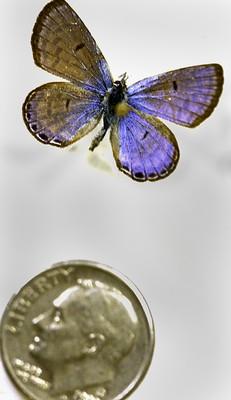SURVIVING ON A WING AND A PRAYER
Scientists who check the pulse of Nevada's fragile plant and animal populations are worried that the Mount Charleston blue butterfly might be sliding toward extinction.
They hope the last of the rare, tiny butterflies with dull iridescent blue wings haven't already vanished.
A few of them were last seen by an expert who monitors the population at two undisclosed locations in 2005 on the mountain, 25 miles west of Las Vegas.
The expert, Bruce Boyd, said there's a chance that some larvae or pupae might still be thriving in the upper soil layer, providing a thread to the subspecies' continued existence.
"I don't know what could be done at this point. If it's headed toward extinction, it's headed toward extinction. I don't think there's a way to intervene," Boyd said Thursday.
His employer, Data Smiths LLC, has been contracted by the U.S. Fish and Wildlife Service to conduct survey work and provide historical information on the butterfly's habitat, said Bob Williams, the service's field supervisor for Nevada.
"Unfortunately, it's been a pretty darn dry year, so conditions are not conducive for them to fly," Williams said.
Adult Mount Charleston blue butterflies typically fly over meadows in July and August, with the more colorful males living only a few days. The females, which have wings that are brown with a blue overlay, live a bit longer.
At the end of last month, the U.S. Fish and Wildlife Service announced it had found "substantial scientific information" to warrant listing the Mount Charleston blue butterfly as either threatened or endangered.
"The finding does not mean we have decided it is appropriate to list the Mount Charleston blue butterfly," Williams said in a May 30 statement.
"We will be conducting a more thorough review of all scientific information available, and I encourage anyone with relevant information concerning the status of the butterfly and its habitat to provide it to us so it can be considered in the review."
The full review, expected to be completed in the fall, was triggered by a petition filed in October 2005 by The Urban Wildlands Group Inc., a nonprofit, Los Angeles-based conservation organization.
Travis Longcore, the group's science director, said the petition was "a wake-up call."
"We're not looking to start a war. This is just to get people doing conservation measures on public land," he said.
Longcore said although the Mount Charleston blue butterfly, or Icaricia shasta charlestonensis, is covered by Clark County's multiple species habitat conservation plan, not much was being done to preserve it.
"The service's findings indicate those mechanisms put in place might have been adequate if they were being done, but they weren't being done," Longcore said.
The Urban Wildlands Group's petition notes that it intends to submit petitions to list "two to four" other Spring Mountains butterflies. Boyd said those probably would include the dark blue butterfly and the Icarioides blue butterfly. Like the Mount Charleston blue, those butterflies are found nowhere else in the world.
Williams said the service has been working with the Las Vegas Ski and Snowboard Resort regarding blading and construction on U.S. Forest Service land where one of the Mount Charleston blue butterfly core colonies exists.
Another colony is in Kyle Canyon on roughly five acres.
In May, the Fish and Wildlife Service concluded after a yearlong review that listing another blue butterfly, the Sand Mountain blue butterfly in Churchill County, was not warranted.
The decision was made in response to a petition by the Center for Biological Diversity and other environmental groups.
Historically, the Mount Charleston blue butterfly has inhabited 15 locations in the Spring Mountains. It was first identified in 1928 but has existed for at least thousands of years, according to the U.S. Fish and Wildlife Service.
Boyd said it's not clear what has caused the Mount Charleston blue's demise and reduced the numbers of other high-elevation butterflies on the mountain.
"Whether it's global warming or regional drought, those species have been isolated, moving up the mountain," Boyd said. "They've seen drought before and survived, but they weren't being impacted by human disturbance, invasive weeds or invasive species."
Boyd, a field biologist, says he's "not a tree hugger. I'm a science guy but I like facts."
"I never was a big believer of global warming, but as time marches on I'm seeing a lot of things," he said. "It's not just butterflies. Why are the honeybees dying? The butterfly fauna as a whole is going through some traumatic change."
Boyd said he's not convinced that disturbance of meadows around Kyle and Lee canyons related to development and the ski area has adversely affected butterfly populations.
In some cases, human activities might have opened areas for colonization of the Mount Charleston blue butterfly, creating habitat that has helped sustain it.
But, he said, "other things," such as wild horses, might have helped spread exotic plant species by distribution of manure containing seeds of those weeds.
The invasive weeds eventually grew and crowded out a native plant, Torrey's milkvetch, the blue butterfly's larval host plant.
Nevertheless, in higher elevations where the horses don't roam and there is no human-caused disturbance of the landscape, the Mount Charleston blue butterfly hasn't been seen in surveys in recent years.




























